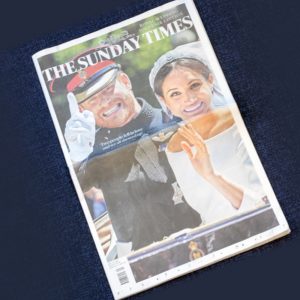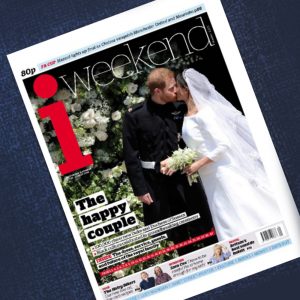
It’s a tough act being a newspaper these days. With television, the internet and social media platforms gearing up for the Big Day months ahead, this was one of the most orchestrated media events the world has ever seen. So how do you compete with live coverage when you have an 18-hour delay before you land on the breakfast table? How do you write original, compelling content, rather than regurgitate what has been said during several hours of live TV coverage and in millions of #royalwedding tweets? Newspaper reporters need to cut it both ways these days – swim with the internet giants and run with the press hounds.
The privileged access offered to newspapers by the Palace is not what it used to be. Take our own paper (no longer published), The Illustrated London News, legendary in its heyday for its coverage of royal events. The editor was automatically allocated a prime seat “in the Abbey” so he could soak up the atmosphere and produce the authoritative eye witness account of the occasion for which the ILN was renowned – be it a Coronation, royal wedding or state funeral.
Not so with the Harry and Meghan’s wedding. Kensington Palace, we gather, initially decreed that no print reporters would be allowed into the Chapel; only TV cameras were offered this privilege. After vigorous lobbying, eventually one Press Association journalist was allowed into the inner sanctum on behalf of all. The rest of the pack were ensconced in a makeshift press room, watching the service on a screen along with 2 billion others around the world, with the variable sound quality and internet connection you would expect in a medieval castle.
Despite these challenges, the royal wedding newspaper coverage demonstrated that newspaper journalism is far from being in the doldrums, thanks to two great factors that set it part. First, the less talked about skill of the picture desk. A picture says a thousand words, but when faced with an instant choice of a thousand pictures, one picture creates a thousand memories. Video may have killed the radio star but it didn’t kill the photo editor. Second, the voices that individually and collectively create a narrative that is rich, memorable and–on the whole–well crafted. There was a sharp contrast between the off-the-cuff commentary of television and Twitter and the considered curation and scrutiny of newspaper journalism. This was most evident in coverage of Bishop Curry’s now legendary sermon. The broadcasters did not know what to make of the sermon, and were either flummoxed or dismissive, no doubt influenced by a few raised eyebrows and ill-judged smirks in the Chapel. By the time the newspapers had paused for thought, digested and published, the sermon was hailed as the single defining factor which set this royal wedding apart from all that have come before.
Nor is it a coincidence that the top newspaper journalists are wheeled in on telly as the experts, with a line up including The Daily Mail‘s Robert Hardman, You Magazine’s Jo Elvin and The Sunday Times’ Roya Nikkhah. If you can’t beat ‘em, join ‘em.
But we shouldn’t feel sorry for newspapers. They make it harder for themselves by the self-imposed rivalry between the Sunday and daily editions. A royal wedding inevitably falls on a Saturday, making the job of the royal correspondent on a daily doubly hard. They need to conjure up something meaningful and fresh 48 hours after the event, when the street parties have packed up and everyone is back at work. Newspapers have had to slash their cost base in recent years, so I find it astonishing that the Chinese walls which exist between the Sundays and dailies under the same brand and ownership have not yet been knocked down. If you were starting a news business today in whatever channel, only lunatics would create a business model with a separate team that is dedicated to a single edition one day a week. If I were in charge of a newspaper, I would get my best team on it every day of the week. What’s for sure there are some top teams out there.
The Illustrated Royal Weddings is available from princeharryroyalwedding.co.uk and retailers including Waitrose, W H Smith in UK and Barnes & Noble in US

The sharpest wordbites in Royal Wedding coverage:
For authority
“It certainly blew the cobwebs off a thousand years of history and showed that at the heart of the establishment, at the very core of our ancient traditions and most hallowed beliefs, there has at last been an acknowledgment that Britain is a changed country and that diversity and inclusion are here to stay.”
Valentine Low, The Times
For perspective
“The most important thing is the Queen wore sunglasses.”
Stuart Heritage, The Times
For slick savagery
“This was The Royal Wedding: the Reality Show, in which everyone was either a star or an extra.”
Camilla Long, The Sunday Times
For the voice of doom
“It may be too much and too unfair to expect the rejoicing around this latest royal wedding to lighten the weight of two burdens: that of the memory of the Diana-tragedy, and that of the anxieties of a nation headed for an exit without any clear sense of destination.”
Simon Schama, Financial Times
For the best Elton soundbite
“The candle in front of [Bishop Curry] swayed dangerously in the tornadic gusts of his enthusiasm. A new kind of candle in the wind.”
Allison Pearson, The Sunday Telegraph
For pure entertainment
“The Duchess of Cornwall turned up in a gigantic pink feathered hat, which seemed to be her personal F… You to every flamingo in the world.”
Caitlin Moran, The Times Magazine
For setting a new barometer
“If a list of hot 61-year olds exists she [Doria Raglan] just zoomed to the top of it.”
Robert Crampton, The Times
For explaining why black is grey
“The euphemism for her dual heritage is ‘modern.’ Somehow, in a country that is riven with discord about who should and should not be here, blackness gets reconfigured as modernity, rather than being recognized as part of our history. “
Suzanne Moore, The Guardian
For a Mum’s perspective
“The sun shone, a choir sang Stand by Me and small flower girls and pageboys behaved perfectly while giggling (the Haribo quota must have been bang on).”
Claudia Winkleman, The Sunday Times
For mastery in misery
“In truth, two institutions, monarchy and the press, are walking hand in hand towards their doom after 400 years of interdependence.”
Roy Greenslade, The Guardian
For summing it up
“There was a national sigh of relief that the bothersome question of the last decade—just who will marry Harry?—had finally been answered. And how.”
Sarah Oliver, Mail on Sunday













